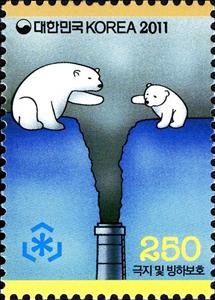Stamp: Environment & Conservation (Global Warming) (Korea, South 2011)
Environment & Conservation (Global Warming) (Korea, South 2011)
03 June (Korea, South ) within release Preserve the Polar Regions and Glaciers goes into circulation Stamp Environment & Conservation (Global Warming) face value 250 South Korean won
| Stamp Environment & Conservation (Global Warming) in catalogues | |
|---|---|
| WADP Numbering System - WNS: | WAD:KR023-11 |
Stamp is vertical format.
Also in the issue Preserve the Polar Regions and Glaciers:
- Stamp - Environment & Conservation (Global Warming) face value 250;
- Stamp - Environment & Conservation (Global Warming) face value 250;
- Se-tenant - Se-tenant Pair face value 2*250;
Stamp Environment & Conservation (Global Warming) it reflects the thematic directions:
The polar bear (Ursus maritimus) is a large bear native to the Arctic and nearby areas. It is closely related to the brown bear, and the two species can interbreed. The polar bear is the largest extant species of bear and land carnivore, with adult males weighing 300–800 kg (660–1,760 lb). The species is sexually dimorphic, as adult females are much smaller. The polar bear is white- or yellowish-furred with black skin and a thick layer of fat. It is more slender than the brown bear, with a narrower skull, longer neck and lower shoulder hump. Its teeth are sharper and more adapted to cutting meat. The paws are large and allow the bear to walk on ice and paddle in the water.
Environmental protection is the practice of protecting the natural environment by individuals, groups and governments.Its objectives are to conserve natural resources and the existing natural environment and, where it is possible, to repair damage and reverse trends.
Animals are multicellular, eukaryotic organisms of the kingdom Animalia (also called Metazoa). All animals are motile, meaning they can move spontaneously and independently, at some point in their lives. Their body plan eventually becomes fixed as they develop, although some undergo a process of metamorphosis later on in their lives. All animals are heterotrophs: they must ingest other organisms or their products for sustenance.



